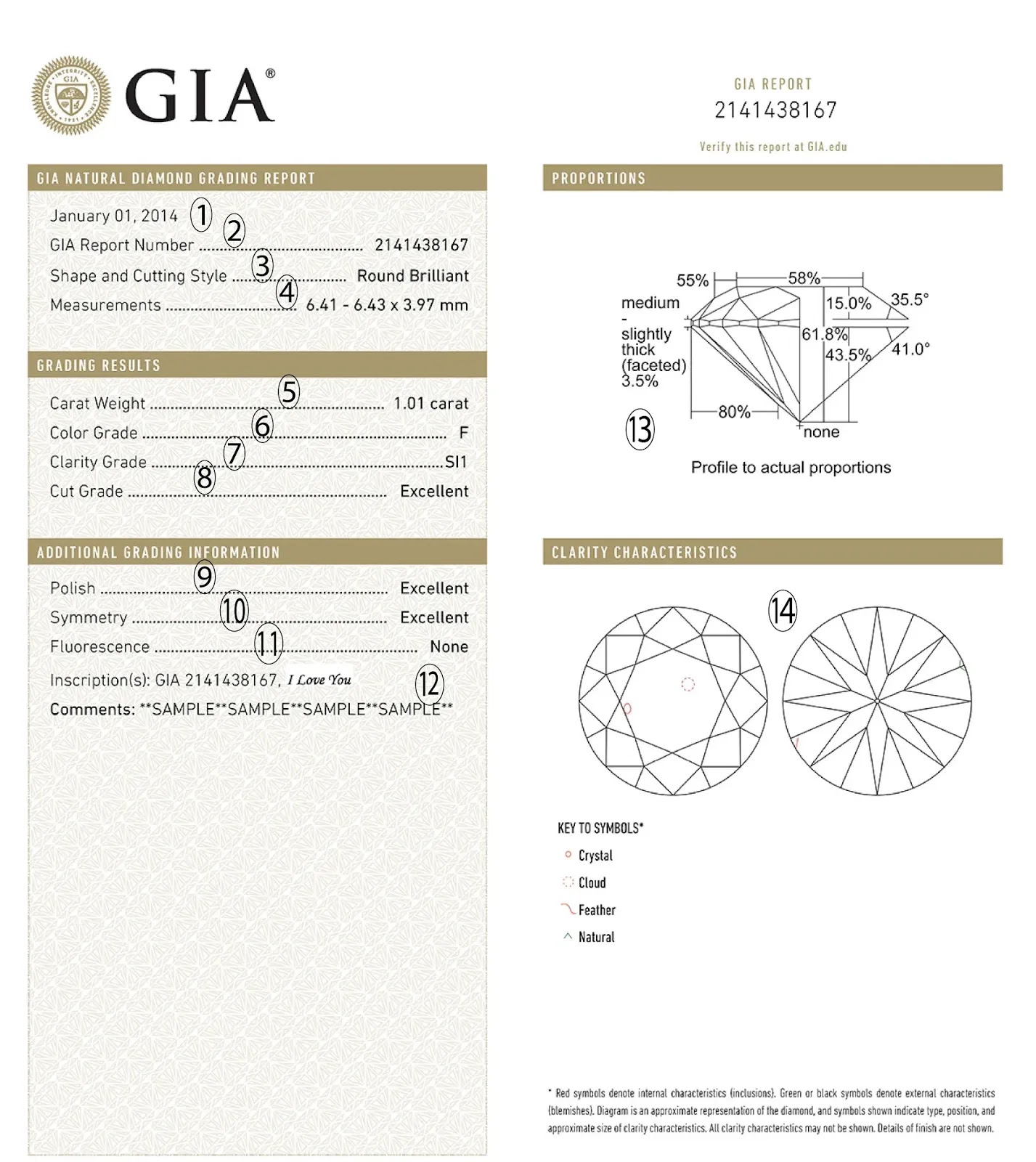How to read and analyze the Diamond Certificate?
A diamond certificate or Diamond report has every kind of detail required to understand the diamonds, you want to purchase. Still, many people are unable to understand or get confused with it. As they look at the certificate, they don’t know how to read it or where to start analyzing the certificate.
For better understanding, we are taking a sample of a Diamond Certificate from The Gemological Institute of America, GIA.
Let’s start with the understanding of the report:
1. Date
The date can tell us several different things. These details help us to judge the diamond. Is it brand new or graded this year? Is it very old or it is previously owned and returned and sold? It helps in deciding what to take. It is not bad to repurchase but only if the Diamond comes back in the best condition. Any damage done to the Diamond afterward, it will not be shown in the report.
2. Gia Report number and Inscription
Every report has a unique number and is also a Laser Inscribed number, this means that the Diamond Report Numbers will be inscribed on the girdle. With the help of diamond tools, you can see the numbers.
The Laser Inscription for the Diamond Report as shown is “214……. “. And Yes, that entire number will be lasered onto the girdle of the diamond.
3. Shape and cutting style
As people generally take the shape and cutting style as the same but these 2 things are different. The shapes are round, pear, square, oval, etc. (click the link to know more about diamond shapes). And the Cutting Style is totally based on how the diamond’s facets are placed. The different cutting style is Brilliant Cut, Single Cut, etc. The most important style is a brilliant cut.
4. Diamond measurement
When it comes to measurements, Diamond’s proportion and size are explained. It can be seen is the diamond is close to Ideal measurements and it will help in taking quick decisions just by comparing the mm sizes.
5. Carat weight
The Carat Weight explains how much the weight is that of the Diamond. To see the carat table you can click here. The weight system is called in points as well. Like:
0.25 CARAT = 25 POINTS
0.50 CARAT = 50 POINTS
0.75 CARAT = 75 POINTS
1 CARAT = 100 POINTS
6. Diamond Color Grade
The Color Grade refers to the type of color or shades which exist in the Diamond. The color can be from D to Z which is explained in detail in the color grade blog.
7. Diamond Clarity grade
The clarity grade shows how many flaws contain in the diamonds. This is also been shown by the chart called Diamond Plot, where the flaws are, shown in the report by marking. To know more about the clarity, you can go to my blog: things to know.
8. Diamond cut grade
The diamond cut grade shows 5 categories:
i. EXCELLENT
ii. VERY GOOD
iii. GOOD
iv. FAIR
v. POOR.
As considerations like table size, culet girdle thickness, etc. are taken.
9. Polish
The Polish of a Diamond explains the smoothness and perfectness of the Facets are Polished. If any Facet has been over-polished or less polished or marked with flaws, they can alter light and even make your diamond look less shiny. Light can reflect off from these flaws and can create a dull impact.
10. Symmetry
Symmetry refers to how closely the same kind of Facets is proportionate. Star Facets should all be perfectly identical, they should all match up and look similar.
11. Fluorescence
Fluorescence means the diamond has a Milky or Cloudy inclusion which makes the diamond looks dull in natural light. Even if that Diamond does not have any Flaws in it, that is a diamond with white Color and an Excellent Cut. The diamond will glow when kept under UV light.
12. Comments
The Comments section of the Certificate explains any additional flaws or inclusions which are not explained in the inclusion chart or the clarity characteristics. Like, pinpoint is not shown in the inclusion chart.
13. Proportions
The diagram shows the actual proportions of the diamond i.e. table size, width size, and girdle thickness, etc. This helps us to understand if the diamond is ideal for buying with the ideal proportion of diamonds.
14. Clarity characteristics
The inclusions in the diamond are shown in the following diagram of the diamond. The inclusions are shown exactly at the same point in the diagram where it exists in diamonds. This helps to easily locate the inclusions in the diamond.
Conclusion:
However, there are many other institutions that are providing the diamond certificate like AGS, IGI, and many others. The looking of the certificate might be different but the overall categories will be the same. We will try to explain other diamond institutions’ certifications as well.

